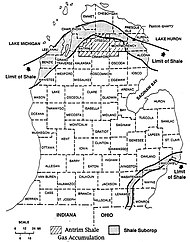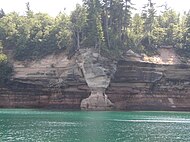| Big Hill Formation | |
|---|---|
| Stratigraphic range: Late Ordovician | |
 Jointed limestone from the Big Hill Formation (Upper Peninsula of Michigan) | |
| Type | Formation |
| Unit of | Richmond Group (geology) |
| Underlies | Manitoulin Dolomite |
| Overlies | Stonington Formation |
| Lithology | |
| Primary | limestone |
| Location | |
| Region | |
| Country | |
The Big Hill Formation is a geologic formation in Michigan. It preserves fossils dating back to the Ordovician period. A fossiliferous site on the Stonington Peninsula (in Delta County) includes a dolomite bed of the Big Hill Formation which has abundant and well-preserved fossils. The most common fossils are soft-bodied medusae (jellyfish), followed by linguloid brachiopods, algae, and arthropods (namely chasmataspidids, leperditid ostracods, and eurypterids). This site is considered a Konservat-Lagerstätte, and is commonly referred to as the Big Hill Lagerstätte or Big Hill Biota. [1] [2]
See also
References
- ^ Lamsdell, James C.; LoDuca, Steven T.; Gunderson, Gerald O.; Meyer, Ronald C.; Briggs, Derek E. G. (2017). "A new Lagerstätte from the Late Ordovician Big Hill Formation, Upper Peninsula, Michigan". Journal of the Geological Society. 174 (1): 18–22. doi: 10.1144/jgs2016-059. ISSN 0016-7649. S2CID 85551499.
- ^ Lamsdell, James C.; Gunderson, Gerald O.; Meyer, Ronald C. (2019-01-08). "A common arthropod from the Late Ordovician Big Hill Lagerstätte (Michigan) reveals an unexpected ecological diversity within Chasmataspidida". BMC Evolutionary Biology. 19 (1): 8. doi: 10.1186/s12862-018-1329-4. ISSN 1471-2148. PMC 6325806. PMID 30621579.
- Various Contributors to the Paleobiology Database. "Fossilworks: Gateway to the Paleobiology Database". Retrieved 17 December 2021.

